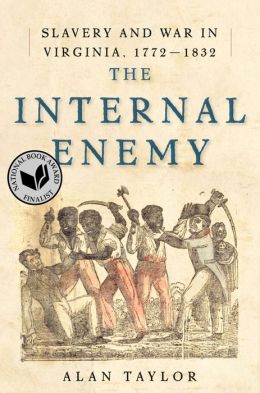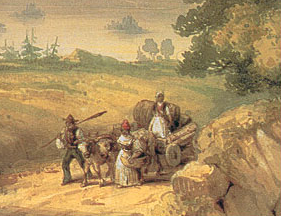
As reported by the Wall Street Journal Bookshelf, "Book Review: 'The Internal Enemy' by Alan Taylor: Slaves were feared in Virginia, yet they wanted to be Americans much more than to murder them," by Mark M. Smith, 13 September 2013 -- Thomas Jefferson and James Madison, so the story goes, were the architects of liberty during the nation's formative years. These Virginians, with their insistent beliefs in American independence and self-determination, were the true stewards of freedom in the Early Republic.
To Alan Taylor this is as much myth as Parson Weems's account of George Washington and the cherry tree. The ideals of freedom expressed so eloquently by Jefferson and Madison were betrayed by their actions. By defending slavery and protecting their economic interests, the men we venerate as the Founding Fathers rendered their proclaimed commitment to liberty shrill and hollow. In his impressively researched and beautifully crafted "The Internal Enemy: Slavery and War in Virginia, 1772-1832," Mr. Taylor introduces us to far less familiar custodians of American liberty—slaves and former slaves like Bartlet Shanklyn, Jack Ditcher and Jeremiah West.

In the past two decades, Mr. Taylor has established himself as one of our leading historians of the Early Republic, with a particular mastery of the social, economic and political intricacies of daily and national life. But he is also a gifted writer, and one committed to narrative history. His main focus here is the War of 1812, but he admirably contextualizes it with a brilliant account of slavery in Virginia during and after the Revolution. He sets out to explore the "causes, course, and consequences of the flight by slaves to join and help the British" during the war years of 1812-15 in an effort to "reveal the social complexities of slavery in Virginia from the American Revolution through Nat Turner's revolt in 1831."
Mr. Taylor shows us that the greatest promoters of liberty in America were the very ones profiting from slavery. The Revolutionary War only tightened the relationship between slavery and freedom. Thanks to slave births, Virginia's enslaved population swelled from 210,000 at the beginning of the war to 236,000 at its conclusion, and slavery remained "as prosperous and important as ever." White Virginians were among the most vocal critics of Britain before and during the revolution and were particular in deploying the language of bondage to make their points. George Washington thought the British aimed to "make us as tame and abject slaves as the blacks we rule over with such arbitrary sway." Men like Jefferson and Madison blasted parliamentary taxes as "chains of slavery" but fought to preserve ownership of two-fifths of the state's population. In this, they saw no contradiction.

Virginia's planters were particularly incensed that British commanders encouraged slaves to flee to their lines and freedom. It didn't occur to them that the 800 Virginia slaves who ran away in 1776 were embracing a version of liberty more ecumenical in scope than the one peddled by the Founding Fathers. Little wonder that around 6,000 slaves fled Virginia plantations during the revolution, many of them finding freedom with the British, whom they saw as champions rather than oppressors.
But for the rest of the enslaved of Virginia, Mr. Taylor shows, the revolution was a calamity. Runaways recovered from the British were sold. Twenty-three slaves escaped Jefferson's Monticello, and he sold all six that he managed to reclaim, principally to punish them for disloyalty. Even more havoc was wrought among slave families when the newly minted Americans discarded the old British laws governing the inheritance of property, abolishing primogeniture and entail. As property that could now be divided among multiple heirs, slave families were suddenly split asunder. The sale of slaves increased after the revolution, with at least 100,000 Virginia slaves sold between 1790 and 1810. The system of slavery emerged stronger after 1776; slaves and their families more vulnerable.
During the War of 1812, Virginia's slaves subscribed to the old adage, the enemy of my enemy is my friend. *Drawing upon memories of the Revolutionary War, they were alert for opportunities to run to British lines and liberty. Roughly 2,400 slaves escaped during the three years of war, and it is on this relatively unexplored exodus that Mr. Taylor trains his eye.

Initially, the British worried about feeding, clothing and freeing such refugees. But they quickly proved their worth as excellent scouts, happy to share their detailed knowledge of Virginia's shoreline, countryside and military positions. The runaways compromised Virginians' "security by identifying militia weak points and hidden shipping to the British." They also empowered the Royal Navy. "Formerly wary of the Chesapeake landscape, the British gained confidence after they recruited runaways for guides," writes Mr. Taylor. The British then did the unthinkable, enlisting 400 male runaways into a special battalion, the Colonial Marines. These troops helped the British strike into Virginia's interior and, eventually, to apply the hard hand of war to the nation's capital.
While the British saw the runaways as a way to strengthen their military position, the slaves were careful to get assurances of their future liberty. In 1814, once it became clear that the runaways were militarily invaluable and essential to securing fresh provisions for the army—once, in other words they had taught the British just how indispensable they were—the ex-slaves insisted that they be allowed to bring their families so that they too would be free. Mr. Taylor identifies a two-stage process here: "In the first, a pioneer runaway made initial contact with the British, and then in the second stage, he returned home to liberate kin and friends." The British, now dependent on the refugees, had little choice but to agree to harbor entire families on their ships.
Slaveholding Virginians loathed the British for encouraging the runaways, which was not only potentially economically ruinous but also perceived as a direct attack on their homes and way of life. Whites lived in a constant "cocoon of dread" of slave revolt. Slaves were their "internal enemy," their presence making planters a fretful, panicky bunch, quick to resort to terrible violence to defend their world. This skittishness clouded the judgment of the masters and blinded them to the basic fact that slaves weren't seeking revenge but, rather, equality and opportunity. "Blacks," says Mr. Taylor, "wanted to be American citizens rather than to murder them." This was what the British understood, and they believed freed slaves fully capable of functioning responsibly in civil society—albeit only as members of the lower rungs.

Americans were deeply offended when the British captured, impressed and whipped white American sailors. The British, they howled, were treating them like slaves and blurring racial lines critical to preserving white, republican freedom. Little had changed in the slaveholding mind-set since the revolution largely because these "otherwise honorable men" still saw the maintenance of slavery "as their duty." These lovers of liberty, Mr. Taylor writes, "sustained an exploitative and encompassing economic system dedicated to property in humans, the pursuit of profit, the rights of creditors, and the interests of heirs" because they saw "no other choice." To them, the institution of slavery and their own liberty were inseparable.
The war resulted in liberty for thousands of Virginia's slaves and their families. The British transported the bulk of refugees—almost 3,000 of them—to the barren soil of Nova Scotia, the Royal Navy's principal North American base, where the former slaves and their families eked out a living. Here they pondered the meaning of their liberty and explained it in letters to their erstwhile masters in Virginia. Bartlet Shanklyn wrote to his: "When I was with you I worked very hard and you neither g[ave] me money nor any satisfaction but sin[ce] I have been hear I am able to make Gold and Silver as well as you." Or, as Jeremiah West wrote to his former Virginia master from Halifax in 1818: "Thank God i can enjoy all comforts under the flag of old England and Here i Shall remain." Jack Ditcher, a slave implicated in an insurrection plot in 1800, summed up the sentiments of many when he declared, "We have as much right to fight for our liberty as any men."

If "The Internal Enemy" makes Virginia's Founding Fathers look appallingly self-absorbed, it also makes them look distinctly human. We tend to ask a great deal of our Founders, placing them on pedestals and expecting utter consonance between their words and actions. In so doing, we have come perilously near to dehumanizing them, in the same way historians used to depict slaves as objects rather than living, thinking agents.
Jefferson and Madison and the legion of slaveholding Virginians were manifestly men of their time and place. Like slaveholders elsewhere, they were on the cusp of momentous historical change. They had been schooled in a world where bondage and unfree labor were historically and geographically the norm. Not so with Virginia's runaways during the War of 1812. They bequeath us a version of freedom born in bondage and refined in the act of escaping from slavery. As such, they offer us a powerful and authentic iteration of the responsibilities and meaning of liberty, one arguably more enduring than the version espoused by the other, more conventional Founders. [source: Wall Street Journal —Mr. Smith, Carolina distinguished professor of history at the University of South Carolina, is completing a book on the sensory history of the Civil War.]

No comments:
Post a Comment